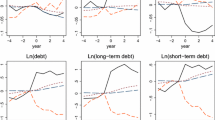Abstract
We examine the debt-equity decisions of startup firms using the Kauffman Firm Survey, the largest database of U.S. startups launched in 2004. To control for sample selection bias and the correlation among financing decisions, we employ a Bivariate Probit-Tobit model. Our results show that several firm characteristics such as growth prospects, firm size, tangible assets, and selling products, as well as owner characteristics such as net worth, experience, education and ethnicity explain the debt-equity decisions in the startup year. In addition, for firms that use debt, we document traits that explain the use of a particular type of business versus personal debt. Larger firms use more business debt, whereas home-based and growth firms use more personal sources of debt. Immigrants, owners who lack work experience and those who invest more time in the business tend to rely more on personal sources of debt.
Similar content being viewed by others
Notes
Multiple imputations involve generating “m” substitute sets for the missing values, which allows for the uncertainty due to imputation to be reflected in the analysis. The KFS data doesn’t suffer from a huge number of missing observations and we get similar results using the non-imputed data.
We exclude external equity as a source of capital since we focus on businesses owned by one or two owners who are actively involved in managing the firm; this prevents any potential agency problem (owner/manager conflict).
References
Ang JS (1992) On the theory of finance for privately held firms. Journal of Small Business Finance 11(3):195–203
Ang J, Lin JW, Tyler F (1995) Evidence on the lack of separation between business and personal risks among small businesses. Journal of Small Business Finance 4:197–210
Ang J, Cole R, Lawson D (2010) The role of owner in capital structure decisions: an analysis of single-owner corporations. Journal of Entrepreneurial Finance 14:1–36
Ballou J, Barton T, DesRoches D, Potter F, Zhao Z, Santos B, Sebastian J (2007). Kauffman Firm Survey (KFS) Baseline Methodology Report. Available at: http://papers.ssrn.com/sol3/papers.cfm?abstract_id=1024045
Ballou J, Barton T, DesRoches D, Potter F, Reedy EJ, Robb A, Shane S, Zhao Z (2008). Kauffman Firm Survey: Results from the baseline and first follow-up surveys. Available at: http://ssrn.com/abstract=1098173
Berger AN, Udell GF (1998) The economics of small business finance: the roles of private equity and debt markets in the financial growth cycle. Journal of Banking and Finance 22:613–673
Bertrand M, Schoar A (2003) Managing with style: the effect of managers on firm policies. Q J Econ 118:1169–1208
Besanko D, Thakor AV (1987a) Collateral and rationing: sorting equilibria in monopolistic and competitive credit markets. Int Econ Rev 28:671–689
Besanko D, Thakor AV (1987b) Competitive equilibrium in the credit market under asymmetric information. J Econ Theory 42:167–183
Boot AW, Thakor AV, Udell GF (1991) Secured lending and default risk: equilibrium analysis and policy implications and empirical results. Economic Journal 101:458–472
Cassar G (2004) The financing of business start-ups. J Bus Ventur 19:261–283
Cole R (2013) What do we know about the capital structure of privately held firms? Evidence from the surveys of small business finance. Financ Manag 42:68–104
Cole R, Sokolyk T 2013. How do start-up firms finance their assets? Evidence from the Kauffman Firm Surveys, Working paper
Coleman S, Cotei C, Farhat J (2013) A resource-based view of new firm survival: new perspectives on the role of industry and exit route. J Dev Entrep 18:25
Cotei C, Farhat J (2011) An application of the two-stage Bivariate Probit-Tobit model to corporate financing decisions. Rev Quant Finan Acc 37:363–380
Frequently Asked Questions (September, 2012). Retrieved from http://www.sba.gov/advocacy on 5/2/2013.
Harris M, Raviv A (1991) The theory of capital structure. J Financ 46:297–355
Hovakimian A, Opler T, Titman S (2001) The debt-equity choice. J Financ Quant Anal 36:1–24
Hovakimian A, Hovakimian G, Tehranian H (2004) Determinants of target capital structure: the case of dual debt and equity issues. J Financ Econ 71:517–540
McInish TH (1982) Individual investors and risk-taking. J Econ Psychol 2:125–136
Meng C, Schmidt P (1985) On the cost of partial observability in the Bivariate Probit model. Int Econ Rev 26:71–85
Myers SC (1977) Determinants of corporate borrowings. J Financ Econ 5:147–175
Myers SC (1984) The capital structure puzzle. J Financ 39:575–592
Myers SC, Majluf NS (1984) Corporate financing and investment decisions when firms have information that investors do not have. J Financ Econ 13:187–221
Nofsinger JR, Wang W (2011) Determinants of start-up firm external financing worldwide. Journal of Banking and Finance 35:2282–2294
Robb AM, Robinson DT 2012. The capital structure decisions of new firms. Review of Financial Studies, forthcoming.
Schmid T (2013) Control considerations, creditor monitoring, and the capital structure of family firms. Journal of Banking and Finance 37:257–272
Stiglitz J, Weiss A (1981) Credit rationing in markets with imperfect information. Am Econ Rev 71:393–410
Titman S, Wessel R (1988) The determinants of capital structure choice. J Financ 43:1–19
Verheul I, Thurik R (2001) Start-up capital: does gender matter? Small Bus Econ 16:329–345
Author information
Authors and Affiliations
Corresponding author
Additional information
Certain data included herein are derived from the Kauffman Firm Survey restricted-access data file. Any opinions, findings, and conclusions or recommendations expressed in this material are those of the author (s) and do not necessarily reflect the views of the Ewing Marion Kauffman Foundation.
Appendix
Appendix
Rights and permissions
About this article
Cite this article
Coleman, S., Cotei, C. & Farhat, J. The debt-equity financing decisions of U.S. startup firms. J Econ Finan 40, 105–126 (2016). https://doi.org/10.1007/s12197-014-9293-3
Published:
Issue Date:
DOI: https://doi.org/10.1007/s12197-014-9293-3




